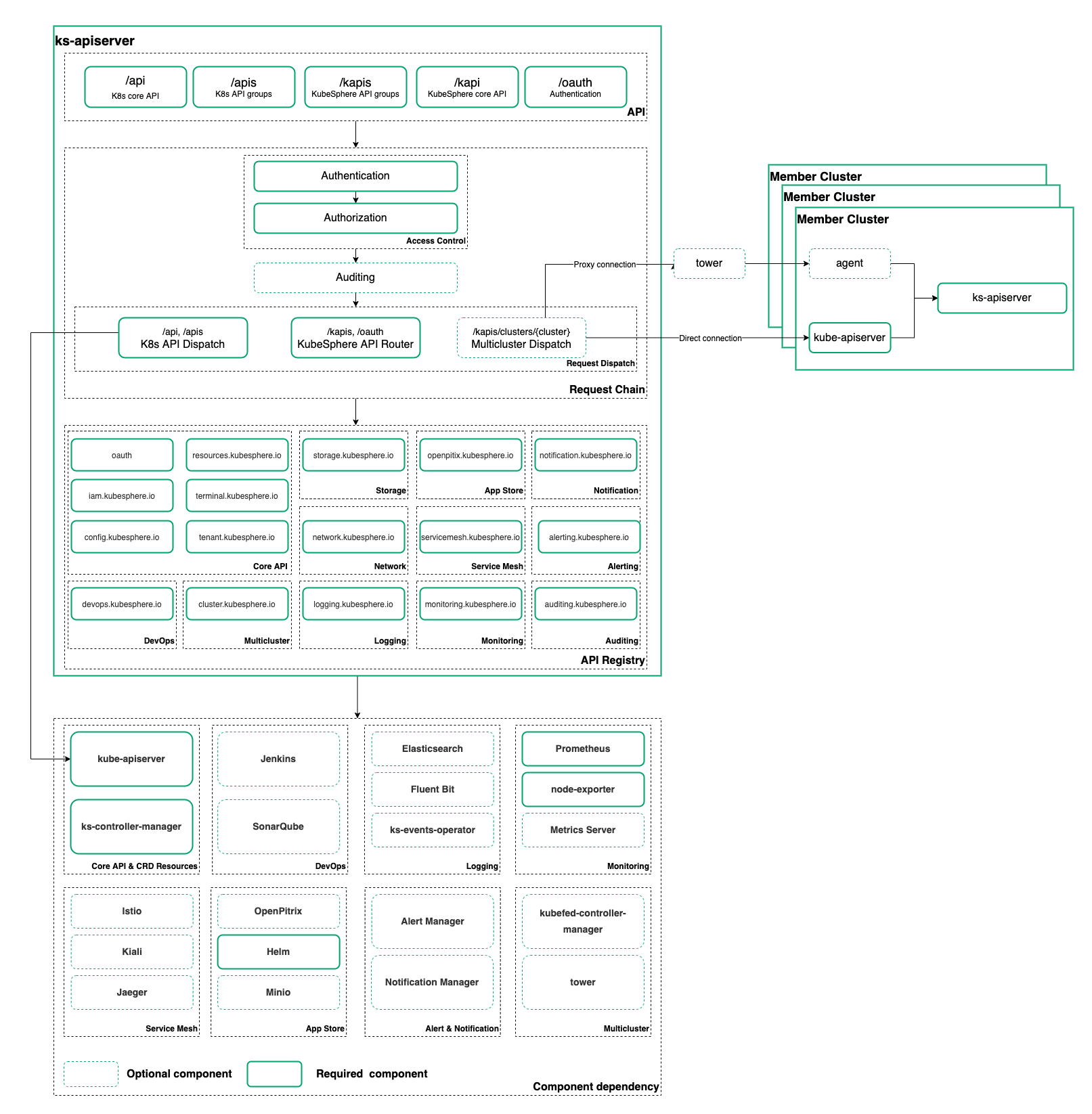
KubeSphere API
Architecture
The KubeSphere API server validates and configures data for API objects. The API Server services REST operations and provides the frontend to the cluster's shared state through which all other components interact.

Use the KubeSphere API
KubeSphere v3.0 moves the functionalities of ks-apigateway and ks-account into ks-apiserver to make the architecture more compact and clear. In order to use the KubeSphere API, you need to expose ks-apiserver to your client.
Step 1: Expose the KubeSphere API service
If you are going to access KubeSphere inside the cluster, you can skip the following section and just use the KubeSphere API server endpoint http://ks-apiserver.kubesphere-system.svc.
On the other hand, you need to expose the KubeSphere API server endpoint outside the cluster first.
There are many ways to expose a Kubernetes service. For demonstration purposes, this example uses NodePort. Change the service type of ks-apiserver to NodePort by using the following command.
$ kubectl -n kubesphere-system patch service ks-apiserver -p '{"spec":{"type":"NodePort"}}'
$ kubectl -n kubesphere-system get svc
NAME TYPE CLUSTER-IP EXTERNAL-IP PORT(S) AGE
etcd ClusterIP 10.233.34.220 <none> 2379/TCP 44d
ks-apiserver NodePort 10.233.15.31 <none> 80:31407/TCP 49d
ks-console NodePort 10.233.3.45 <none> 80:30880/TCP 49d
Now, you can access ks-apiserver outside the cluster through the URL like http://[node ip]:31407, where [node ip] means the IP address of any node in your cluster.
Step 2: Generate a token
You need to identify yourself before making any call to the API server. The following example uses the password P#$$w0rd. The user needs to issue a request to generate a token as below:
curl -X POST -H 'Content-Type: application/x-www-form-urlencoded' \
'http://[node ip]:31407/oauth/token' \
--data-urlencode 'grant_type=password' \
--data-urlencode 'username=admin' \
--data-urlencode 'password=P#$$w0rd' \
--data-urlencode 'client_id=kubesphere' \
--data-urlencode 'client_secret=kubesphere'
Note
[node ip] with your actual IP address. You can configure client credentials in ClusterConfiguration, there is a default client credential client_id and client_secret is kubesphere.If the identity is correct, the server will respond as shown in the following output. access_token is the token to access the KubeSphere API Server.
{
"access_token": "eyJhbGciOiJIUzI1NiIsInR5cCI6IkpXVCJ9.eyJ1c2VybmFtZSI6ImFkbWluIiwidWlkIjoiYTlhNjJmOTEtYWQ2Yi00MjRlLWIxNWEtZTFkOTcyNmUzNDFhIiwidG9rZW5fdHlwZSI6ImFjY2Vzc190b2tlbiIsImV4cCI6MTYwMDg1MjM5OCwiaWF0IjoxNjAwODQ1MTk4LCJpc3MiOiJrdWJlc3BoZXJlIiwibmJmIjoxNjAwODQ1MTk4fQ.Hcyf-CPMeq8XyQQLz5PO-oE1Rp1QVkOeV_5J2oX1hvU",
"token_type": "Bearer",
"refresh_token": "eyJhbGciOiJIUzI1NiIsInR5cCI6IkpXVCJ9.eyJ1c2VybmFtZSI6ImFkbWluIiwidWlkIjoiYTlhNjJmOTEtYWQ2Yi00MjRlLWIxNWEtZTFkOTcyNmUzNDFhIiwidG9rZW5fdHlwZSI6InJlZnJlc2hfdG9rZW4iLCJleHAiOjE2MDA4NTk1OTgsImlhdCI6MTYwMDg0NTE5OCwiaXNzIjoia3ViZXNwaGVyZSIsIm5iZiI6MTYwMDg0NTE5OH0.PerssCLVXJD7BuCF3Ow8QUNYLQxjwqC8m9iOkRRD6Tc",
"expires_in": 7200
}
Step 3: Make the call
If you have everything you need to access the KubeSphere API server, make the call using the access token acquired above as shown in the following example to get the node list:
$ curl -X GET -H "Authorization: Bearer eyJhbGciOiJIUzI1NiIsInR5cCI6IkpXVCJ9.eyJ1c2VybmFtZSI6ImFkbWluIiwidWlkIjoiYTlhNjJmOTEtYWQ2Yi00MjRlLWIxNWEtZTFkOTcyNmUzNDFhIiwidG9rZW5fdHlwZSI6ImFjY2Vzc190b2tlbiIsImV4cCI6MTYwMDg1MjM5OCwiaWF0IjoxNjAwODQ1MTk4LCJpc3MiOiJrdWJlc3BoZXJlIiwibmJmIjoxNjAwODQ1MTk4fQ.Hcyf-CPMeq8XyQQLz5PO-oE1Rp1QVkOeV_5J2oX1hvU" \
-H 'Content-Type: application/json' \
'http://[node ip]:31407/kapis/resources.kubesphere.io/v1alpha3/nodes'
{
"items": [
{
"metadata": {
"name": "node3",
"selfLink": "/api/v1/nodes/node3",
"uid": "dd8c01f3-76e8-4695-9e54-45be90d9ec53",
"resourceVersion": "84170589",
"creationTimestamp": "2020-06-18T07:36:41Z",
"labels": {
"a": "a",
"beta.kubernetes.io/arch": "amd64",
"beta.kubernetes.io/os": "linux",
"gitpod.io/theia.v0.4.0": "available",
"gitpod.io/ws-sync": "available",
"kubernetes.io/arch": "amd64",
"kubernetes.io/hostname": "node3",
"kubernetes.io/os": "linux",
"kubernetes.io/role": "new",
"node-role.kubernetes.io/worker": "",
"topology.disk.csi.qingcloud.com/instance-type": "Standard",
"topology.disk.csi.qingcloud.com/zone": "ap2a"
},
"annotations": {
"csi.volume.kubernetes.io/nodeid": "{\"disk.csi.qingcloud.com\":\"i-icjxhi1e\"}",
"kubeadm.alpha.kubernetes.io/cri-socket": "/var/run/dockershim.sock",
"node.alpha.kubernetes.io/ttl": "0",
....
Note
[node ip] with your actual IP address.API Reference
The KubeSphere API swagger JSON file can be found in the repository https://github.com/kubesphere/kubesphere/tree/release-3.3/api.
- KubeSphere specified the API swagger json file. It contains all the APIs that are only applied to KubeSphere.
- KubeSphere specified the CRD swagger json file. It contains all the generated CRDs API documentation. It is same as Kubernetes API objects.
You can explore the KubeSphere API document from here as well.
Feedback
Was this page Helpful?
Receive the latest news, articles and updates from KubeSphere
Thanks for the feedback. If you have a specific question about how to use KubeSphere, ask it on Slack. Open an issue in the GitHub repo if you want to report a problem or suggest an improvement.












 Previous
Previous
